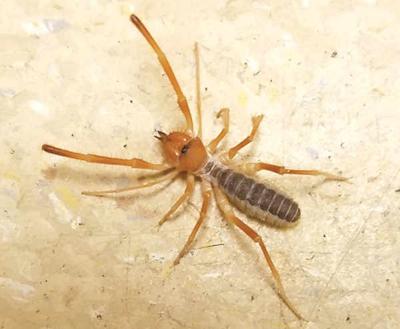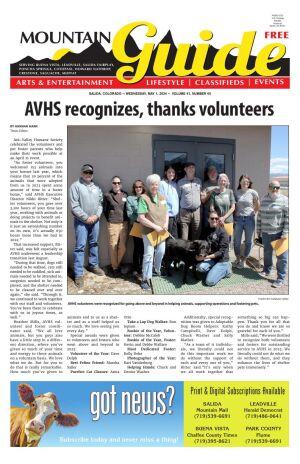Salidan Helen Scott said she normally runs from bugs. However, after listening to a speech from Nathrop’s Denny Radabaugh called “In Defense of Spiders,” her curiosity outweighed her fear when a camel spider, also known as a wind scorpion, wandered into the room where she was getting a knee injection.
“I looked down at the floor and there was this bug,” Scott said. “The nurse was also pretty interested and he helped me collect it. I took a picture and sent it to Denny.”
“I was amazed,” Radabaugh said about receiving the picture. “I knew what it was instantly.”
Radabaugh, who worked as a biology professor for 38 years, said he had seen one other camel spider in his life, and that one was in Africa.
The arachnid lives in deserts and borderline desert areas, which Radabaugh said Salida qualifies as. Its speed and sneakiness, however, make it elusive.
“It’s rarely seen,” Radabaugh said. “I don’t think anyone knows a lot about their population density; it’s probably not very dense.”
He added that people could live in the area their whole lives and never see one.
The insect’s common names are also misnomers; it is neither a spider nor a scorpion. The bug is an arachnid and shares a number of characteristics with spiders, but it is actually a Solifugae.
The parts of its mouth and the two-part body of the camel spider make it look similar to a spider, but it doesn’t have spinnerets, which are used to spin silk, which are unique to spiders.
Its jaw, meanwhile, is unique to it.
“Its pincher-like jaw is just huge proportionally,” Radabaugh said. “They’re not venomous, but they can bite very hard.”
While Solifugae might look scary, fighting wouldn’t be its first choice.
“It’s not aggressive,” Radabaugh said. “If it had a choice, it would move out of the way to get out of trouble, but if pressed it would defend itself.”
Solifugae can also move unexpectedly fast, with a top speed around 10 mph.
Radabaugh said he suspected the one Scott caught was “dehydrated and in pretty bad shape,” adding, “that’s the only reason they caught it.”
The camel spider can also grow as big as 6 inches, but Radabaugh said the local ones are “fairly small,” getting to be a “couple inches” big at most.
Beyond the basics, not much is known about the camel spider. Paula Cushing at the Denver Museum of Science and Nature just received a $1 million grant to study it over the next four years and extend the knowledge of Solifugae in North America.
“They’re very committed to understanding and documenting biodiversity around the planet,” Radabaugh said. “We’re already in the process of species going extinct in enormously high rates.”
The Solifugae captured in Salida eventually died in captivity, but Radabaugh reached out to Cushing and said the specimen will end up in the Denver Museum of Science and Nature.
If someone does happen to see one in the wild, there’s no need to worry.
“Just appreciate that you’re seeing such a rare creature,” Radabaugh said. “There’s nothing to be concerned about.”









(0) comments
Welcome to the discussion.
Log In
Keep it Clean. Please avoid obscene, vulgar, lewd, racist or sexually-oriented language.
PLEASE TURN OFF YOUR CAPS LOCK.
Don't Threaten. Threats of harming another person will not be tolerated.
Be Truthful. Don't knowingly lie about anyone or anything.
Be Nice. No racism, sexism or any sort of -ism that is degrading to another person.
Be Proactive. Use the 'Report' link on each comment to let us know of abusive posts.
Share with Us. We'd love to hear eyewitness accounts, the history behind an article.